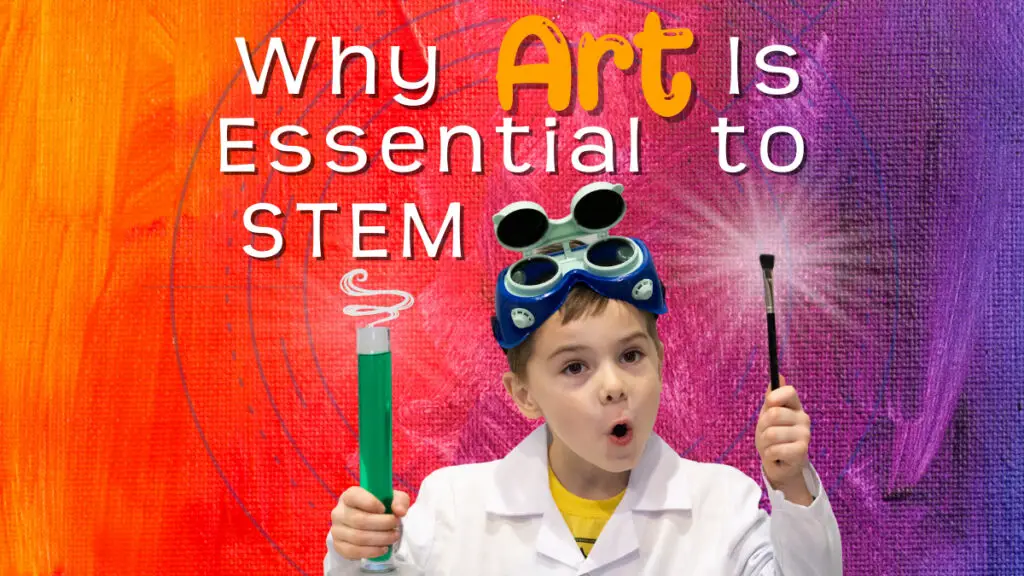The arts and sciences have traditionally been grouped into silos, but no one told the human brain about that. Certain students may have a marked predilection for one or the other resulting in the myth that if you are a STEM student, art is outside the field of study and vice versa. The fact is that many art students are just as good at STEM subjects but prefer the arts.
Art is essential as it provides valuable skills not directly found in STEM. Flexibility, adaptability, creativity, communication skills, imagination, and intuition come through studying art. Research shows that students who study art and science are more motivated in all their studies.

When we talk about art, we mean subjects such as visual arts, music, history, languages, and fine arts. There is beauty in science and art. Many revered artists, such as Leonardo da Vinci, M. C. Escher, Johann Sebastian Bach, Albrecht Dürer, and snow artist Simon Beck have combined art and mathematics in surprising ways. If your child is a polymath, you could be doing them (and the world) a disservice by ignoring opportunities to pursue art.
You can read more about notable artist-scientists in our post on the differences between STEM and STEAM.
Studying STEM Exclusively Does Not Develop The Whole Brain
STEM subjects tend to teach sets of rules, and while promoting innovation and creative thinking, school-level students are essentially learning these rules and how to apply them. While STEM blends subjects and encourages highly analytical and critical thinking it doesn’t directly teach creative, out-of-the-box mental skills in the same way found in the arts, and humanities courses are largely absent.
The left brain is generally associated with logic, mathematics, analytics, speech, and logistics, whereas the right brain is more about spatial ability, visual imagery, creativity, music, and emotion. While they each work well in their own unique areas, they work best together. A young child’s education should offer opportunities to develop both left-brain and right-brain skills while the brain is still growing.
Like Steve Jobs and Albert Einstein, many successful people have imaginative and intuitive abilities that boosted their analytical side. People who focus exclusively on STEM sometimes forget that both sides of the brain determine personality traits and personal abilities. Exposing STEM students to art broadens their horizons, gives them a cultural identity and moral values approved by their society.
Arts Promote Communication Skills And Creativity
The ability to communicate at different levels is crucial to the development of new ideas. Art helps students to strengthen their design skills, imagination, and, most of all, creativity. It helps them understand history, culture, and politics, basically how the world works, so that they are better equipped to deal with life’s problems.
Writing a technical report, selling a new invention to investors, imagining a solution to a problem, designing an aesthetically pleasing bridge, or building require skills usually found in art. While no one doubts the value of STEM in our technological age, it is too easy to undervalue the skills provided by art.
Engineering weighs heavily on design skills, as does art. One favors function, the other favors aesthetics. Both are important, especially when bringing a product to market. Think of the design that goes into building a car or vehicle, and consider both form and function.
For example, the Corvette Stingray, as noted in this HuffPost article, was voted “North American Car of the Year, is an engineering marvel and one of the top-performing automobiles on the market. But, it’s also aesthetically appealing.” It’s important that it work efficiently, but if it’s ugly even the most brilliant product’s marketability suffers. Both aspects are important.
Art exposes a child to new ideas and different ways of perceiving problems. Software engineers, biotechnologists, mathematicians, and laboratory scientists know that a high degree of creativity is essential to advance their fields, make new discoveries, and solve real-world problems. Art helps a child to grow that creativity.
In a study by the National Endowment For The Arts, it was found that:
- arts students were twenty-one percent more likely than non-arts students to have attended a post-secondary institution two years after high school graduation;
- arts students pursued STEM majors at rates similar to their non-arts peers – i.e., they were not less likely to pursue STEM careers because they devoted some of their high school subject choices to the arts;
- arts students received scholarships to post-secondary institutions at a similar rate to non-arts students.
Related Posts: Do STEM schools teach English Language Arts or History and social studies?
STEM vs STEAM
Most criticism of STEM points to the gap created by the exclusion of the arts. Educators are starting to increasingly realize the value of introducing art into STEM education, and morphing from STEM to STEAM. STEAM stands for Science, Technology, Arts, and Mathematics. Studies have shown that students with a strong Arts foundation perform better overall academically. The University of Florida, for example, found that students who studied the arts for four years in high school scored ninety-eight points higher on SATS when compared to those who studied arts for six months or less.
By including arts subjects in high school, students have opportunities to explore and develop their unique talents and abilities. It would be a great tragedy to force someone with the potential to be a brilliant architect to become a mediocre technician because STEM excludes art. For all that the world needs scientists, technologists, engineers, and mathematicians, it also needs graphic designers, architects, caregivers, linguists, therapists, and communicators.
Several studies have shown that including arts subjects in STEM education improves student motivation in all areas of learning. Including arts subjects in a STEM curriculum can encourage awareness in students of the relationship between society and technology. Robotics is an area that needs science and technology but also human psychology, societal and moral values.
Related Post: STEM 101 – What every parent should know about STEM education
It’s about the individual
Not everyone needs to be a software engineer or microbiologist. For some STEM fields like these are their calling; others, not so much. There is a need for people to fill other roles as well.
Ultimately, it doesn’t have to be STEM OR STEAM. Really, there’s room for both to provide students with greater choice. STEAM aims to include some gaps in STEAM curriculum, though STEM purists will argue that the arts dilute the hard sciences and math.
The goals of both are largely the same: to combine the knowledge from different areas of education to create, design, innovate, make discoveries, and solve problems. STEM and STEAM education are both dedicated to doing the best job to prepare students for the future.
Future Jobs and Artificial Intelligence
So, let’s talk about the future for a moment. Some of that innovative thinking has led to developments in Artificial Intelligence. AI is finding new ways into our daily lives (It’s already here – self driving cars, predictive text, translation software, medical diagnosis, and a myriad of other applications.) On its current path, AI could render lower-level and even mid-level jobs defunct – including some jobs STEM graduates may expect to fill.

A 2017 paper entitled “The Growing Importance of Social Skills in the Labor Market” by a Harvard professor of education noted that between 1980 and 2012, jobs requiring high levels of social interaction grew by almost 12 percentage points.
Shirley Malcom, the head of education and human resources at the American Association for the Advancement of Science, has said that STEM skills alone may not be enough. She says that it is necessary to create a workforce ready for the challenges of AI that is taught to think differently.
According to Malcom, this means looking at broader interdisciplinary topics that promote interpersonal skills, continued learning abilities, and adaptability to different environments.
Experts believe that future jobs will require three critical elements – STEM education, creativity, and emotional intelligence. That said, the fastest-growing careers according to ICS Canada for the past half decade may surprise:
- Community and social service workers
- Occupational therapists
- Cooks
- Financial auditors
- Computer Programmers
- Early childhood educators.
According to research by the Brookings Institute, jobs that face a high risk of exposure to artificial intelligence include white collar jobs in engineering, science, and production. Other data shows that AI and robotics developments put repetitive manual jobs at risk.
Damion Shelton, CEO of Agility Robotics made the statement, “The suggestion to replace employees doesn’t make sense. What makes sense is leveraging technology to supplement, or augment, a human workforce,” Shelton said. “Doing so does two things: it helps companies meet customer demand, and it frees the human workforce into jobs that require decision making, creativity, and collaboration.”
So, the workforce is shifting across the spectrum. Some jobs today may be obsolete in a future job market, making room for other jobs leaning more towards soft skills that cannot be automated. As new technologies emerge, there becomes a need for new skill sets. Who would have thought years ago that their would be a need for something like AI prompt engineering?
Wrap Up – How Art Fits into STEM
Even though this is STEMtropolis, we embrace both STEM and STEAM.
It’s not about choosing STEM or STEAM. It’s about choosing the right path for each student. Some people are happiest crunching numbers, analyzing data, tweaking, and testing. Others are more comfortable creating. It’s not a competition, it’s a choice. The world needs artists just as much as it needs scientists or mathematicians.
As we look towards future job markets, soft skills may be increasingly important. Quantum computing and AI may be poised to do most of the heavy lifting in many jobs functions, including STEM fields. Jobs that are likely to survive an AI revolution are those that require a human touch and soft skills.
Careers take strange paths sometimes. For my part, I’ve had jobs that may seem firmly rooted one way or the other. I’ve toured for many years as a professional musician and plied my trade in Information Technology as a Systems Administrator, Technical Architect, and consultant. I’m a writer, photographer, and instructor. I can attest that the arts bolstered my technical endeavors, and what I learned doing techie and corporate jobs influences my art.
Exposure to art can give STEM students a path to grow their imaginations, intuitional abilities, and understanding of society. The one thing that distinguishes humans from computer intelligence is that creative spark. Our human creativity gives us the ability to make intuitive leaps, dream dreams of how the world should be, and decide what is beautiful. This is art.
Related Post: How Music fits into a STEM program
Read more about STEM education in our post STEM Education 101: What every Parent Must Know

